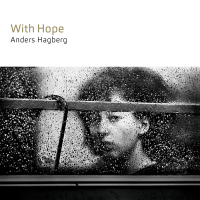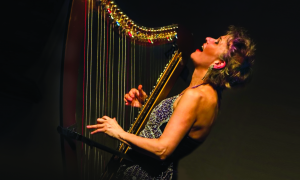
Guitarist Grant Green had two significant careers. The first was as a Blue Note artist who recorded 29 albums for the label between 1960 and 1972, most of them straight ahead jazz. The other career was as a funky soul-jazz player who recorded important riff-driven albums for other labels starting in 1965 (His Majesty King Funk for Verve). This career was eclipsed by the rapid rise of the jazz fusion movement.
One album that bridged these two careers was his last album for Blue Note—Live at the Lighthouse—a masterpiece. Recorded at the Lighthouse in Hermosa Beach, Ca., in April 1972, the album featured Green (g), Claude Bartee (ss,ts), Gary Coleman (vib), Shelton Laster (org), Wilton Felder (el. b), Greg Williams (d) and Bobbye Porter Hall (perc). On the album, Green's band was on fire. It's impossible to overstate how together this soul-jazz septet was. It had a groove, blistering soloists and all were long-form players, meaning they could keep audiences hypnotized for an extended period of time.
The album's tracks are Neal Creque's Windjammer, the Stylistics' Betcha By Golly Wow, Donald Byrd's Fancy Free, Shelton Laster's Flood in Franklin Park, Mose Davis's Jan Jan and Johnny Bristol and Marilyn McLeod's Walk in the Night. Produced by George Butler, the record originally was a double album with tracks running upward of 15 minutes (Flood in Franklin Park).
The soul-jazz sound captured by this album existed for a very brief period of time, running roughly from 1969 to 1974. At the time, soul powerhouse artists such as Marvin Gaye, Isaac Hayes, Curtis Mayfield, Stevie Wonder and many others were releasing exciting new albums and reachign FM radio audiences with socially conscious albums. Artists were finally able to abandon short-form formulas used on AM radio. With the 12-inch LP, they had room to experiment and expand. Album soul's popularity quickly rolled over to jazz, since many of the musicians brought in to play as sidemen were jazz musicians.
Prestige was the leader in the soul-jazz movement, but Blue Note wasn't far behind. Green understood how jazz could use soul recordings like American songbook standards—as currency with a wider, knowing young-adult audience by creating instrumental interpretations. As you can hear on Live at the Lighthouse, Green had a wild thing going on without veering into avant-garde or free-form jazz. Instead, Green's approach burned and smoldered with funk and in some respects holds up better today than some of the major fusion albums of yore.
Green left Blue Note after his Lighthouse album. My guess is he wanted more artistic say and identified with the hipper soul movement than the jazz-rock scene, which was loaded down with music-school sophistication and spiritual mysticism. I've always enjoyed Green's handful of 1970s albums, though others don't see the value. There was a new energy in soul that suited him. Everything he wanted to say in the jazz vernacular had been said on the Blue Note sessions, many of which the label failed to release until much later. Soul was a language he understood.
After spending a good chunk of 1978 in the hospital, Green went out on the road. In New York, following a gig at George Benson's Breezin' Lounge, he died of a heart attack in his car. Green was just 43.
JazzWax clips: Here's the full album...
One album that bridged these two careers was his last album for Blue Note—Live at the Lighthouse—a masterpiece. Recorded at the Lighthouse in Hermosa Beach, Ca., in April 1972, the album featured Green (g), Claude Bartee (ss,ts), Gary Coleman (vib), Shelton Laster (org), Wilton Felder (el. b), Greg Williams (d) and Bobbye Porter Hall (perc). On the album, Green's band was on fire. It's impossible to overstate how together this soul-jazz septet was. It had a groove, blistering soloists and all were long-form players, meaning they could keep audiences hypnotized for an extended period of time.
The album's tracks are Neal Creque's Windjammer, the Stylistics' Betcha By Golly Wow, Donald Byrd's Fancy Free, Shelton Laster's Flood in Franklin Park, Mose Davis's Jan Jan and Johnny Bristol and Marilyn McLeod's Walk in the Night. Produced by George Butler, the record originally was a double album with tracks running upward of 15 minutes (Flood in Franklin Park).
The soul-jazz sound captured by this album existed for a very brief period of time, running roughly from 1969 to 1974. At the time, soul powerhouse artists such as Marvin Gaye, Isaac Hayes, Curtis Mayfield, Stevie Wonder and many others were releasing exciting new albums and reachign FM radio audiences with socially conscious albums. Artists were finally able to abandon short-form formulas used on AM radio. With the 12-inch LP, they had room to experiment and expand. Album soul's popularity quickly rolled over to jazz, since many of the musicians brought in to play as sidemen were jazz musicians.
Prestige was the leader in the soul-jazz movement, but Blue Note wasn't far behind. Green understood how jazz could use soul recordings like American songbook standards—as currency with a wider, knowing young-adult audience by creating instrumental interpretations. As you can hear on Live at the Lighthouse, Green had a wild thing going on without veering into avant-garde or free-form jazz. Instead, Green's approach burned and smoldered with funk and in some respects holds up better today than some of the major fusion albums of yore.
Green left Blue Note after his Lighthouse album. My guess is he wanted more artistic say and identified with the hipper soul movement than the jazz-rock scene, which was loaded down with music-school sophistication and spiritual mysticism. I've always enjoyed Green's handful of 1970s albums, though others don't see the value. There was a new energy in soul that suited him. Everything he wanted to say in the jazz vernacular had been said on the Blue Note sessions, many of which the label failed to release until much later. Soul was a language he understood.
After spending a good chunk of 1978 in the hospital, Green went out on the road. In New York, following a gig at George Benson's Breezin' Lounge, he died of a heart attack in his car. Green was just 43.
JazzWax clips: Here's the full album...
This story appears courtesy of JazzWax by Marc Myers.
Copyright © 2026. All rights reserved.























